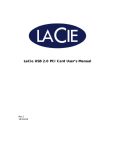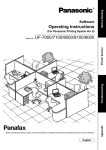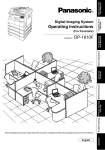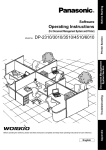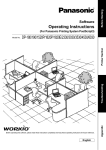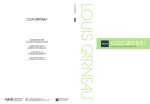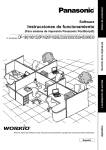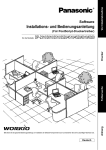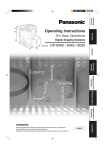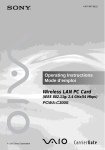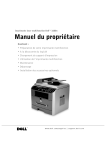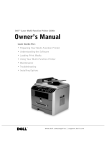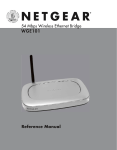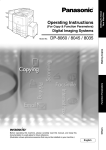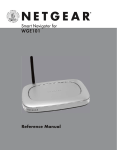Download DP-2310/3010/3510/4510/6010 Operating Instructions
Transcript
Operating Instructions Before Starting Software (For Panasonic Printing System Ver. 6) DP-2310/3010/3510/4510/6010 Before operating this software, please read these instructions completely and keep these operating instructions for future reference. English Appendix Troubleshooting Troubleshooting Printer Section Model No. The following trademarks and registered trademarks are used throughout this manual: Microsoft, MS-DOS, Windows and Windows NT are registered trademarks of Microsoft Corporation in the USA and other countries. i386, i486 and Pentium are trademarks of Intel Corporation. Centronics is a registered trademark of Centronics Data Computer Corporation. TrueType is a registered trademark of Apple Computer, Inc. PEERLESSPAGE TM is a trademark of the PEERLESS System Corporation; and, PEERLESSPrint R and Memory Reduction Technology R are registered trademarks PEERLESS System Corporation; and COPYRIGHT C 2000 PEERLESS System Corporation Universal Font Scaling Technology (UFST) and all typefaces have been licensed from Agfa Monotype. All other trademarks identified herein are the property of their respective owners. Copyright C 2003 by Panasonic Communications Co., Ltd. All rights reserved. Unauthorized copying and distribution is a violation of law. Published in Japan. The contents of these Operating Instructions are subject to change without notice. 2 Table of Contents Before Starting Precautions ..................................................................................................................... ■ For Users in the USA ..................................................................................... 4 4 Printer Section Installing the Printer Driver .......................................................................................... 5 ■ Windows 98/Me/NT/2000/XP ......................................................................... ■ Connecting with a USB Cable (Windows 98) ................................................. ■ Connecting with a USB Cable (Windows Me) ................................................ ■ Connecting with a USB Cable (Windows 2000) ............................................. ■ Connecting with a USB Cable (Windows XP) ................................................ 5 11 15 18 21 ■ Windows 98/Me.............................................................................................. ■ Windows NT 4.0 ............................................................................................. ■ Windows 2000/XP .......................................................................................... 23 27 31 ■ Windows 98/Me.............................................................................................. ■ Windows NT 4.0 (Administrator) .................................................................... ■ Windows NT 4.0 (User) .................................................................................. ■ Windows 2000/XP (Administrator) ................................................................. ■ Windows 2000/XP (User) ............................................................................... ■ All Windows Common Settings ...................................................................... 35 43 51 52 61 62 ■ Printing from Windows Applications ............................................................... ■ Printing on Network ........................................................................................ ■ Internet Printing Protocol (IPP) Printing ......................................................... ■ Setting the IPP Printing .................................................................................. 74 75 77 77 Installing the LPR (Line Printer Remote) Monitor ....................................................... 23 Configuring the Printer Driver Settings ....................................................................... 35 Print Operation ............................................................................................................... 74 Troubleshooting Troubleshooting ............................................................................................................. 80 ■ Printing Operation Fails.................................................................................. ■ Document is Not Printed Correctly ................................................................. 80 81 Appendix Appendix ......................................................................................................................... 82 ■ Printing Area................................................................................................... ■ Symbol Table ................................................................................................. 82 83 3 Before Starting Precautions For Users in the USA This equipment has been tested and found to comply with the limits for a Class A digital device, pursuant to part 15 of the FCC Rules. These limits are designed to provide reasonable protection against harmful interference when the equipment is operated in a commercial environment. This equipment generates, uses, and can radiate radio frequency energy and, if not installed and used in accordance with the Operating Guide, may cause harmful interference to radio communications. Operation of this equipment in a residential area is likely to cause harmful interference in which case the user will be required to correct the interference at his/her own expense. Any unauthorized changes or modifications to this equipment would void the users authority to operate this device. Warning: To assure continued compliance, use only a shielded interface cable when connecting the machine’s parallel interface port to the host computer. Also, any changes or modifications not expressly approved by the party responsible for compliance could void the user's authority to operate this equipment. This device complies with Part 15 of the FCC Rules. Operation is subject to the following two conditions: (1) This device may not cause harmful interference, and (2) this device must accept any interference received, including interference that may cause undesired operation. • You need to read the software license agreement before setting up the Printer Driver. • You need to read the following precautions which are described in the Copier & Facsimile and Internet Fax Operating IInstructions manuals. 1. Installation 2. Ventilation 3. Handling 4. Toner and Paper 5. For Your Safety 4 Printer Section Installing the Printer Driver Windows 98/Me/NT/2000/XP 1 2 (See Note 1) Insert the Panasonic Printing System CD-ROM. 3 Click the Next Printer Section Click on the desired language. button. Note for Windows 98/Me users: If your computer does not have the LPR Port Monitor installed, please proceed to "Installing the LPR Monitor" on page 23 before continuing this installation. 4 Click Install Printer Driver. 5 Click the Typical or Custom button. (See Note 2 on page10) Continued on the next page... 5 Installing the Printer Driver Windows 98/Me/NT/2000/XP 6 Select your machine's model(s) check box and 7 <For DP-2310/3010 only> click the Next button. Select how your machine will be used, either as a Network Printer or as a USB Printer. If USB Printer is selected, click the Next button and skip to Step 11. Note: Make sure that the Power Switch of your machine is OFF and the USB cable is not connected to your computer. 8 Check LPT1: and click the 9 Click the Next button. (See Note 3 on page 10) Yes button if you would like to change your current default printer to the one that you are installing. Note: This dialog box only appears if another printer is already installed. 6 Installing the Printer Driver Windows 98/Me/NT/2000/XP 10 Select your new default printer from the New 11 The required files are copied. 12a Next button. Printer Section Printer List and click the <Windows 98/Me> When this message appears, turn the Power Switch of your machine ON and connect your machine to an available USB Port on your computer. Continued on the next page... 7 Installing the Printer Driver Windows 98/Me/NT/2000/XP 12b <Windows 2000> Click the Yes button. When this message appears, turn the Power Switch of your machine ON and connect your machine to an available USB Port on your computer. Click the 8 Yes button. Installing the Printer Driver Windows 98/Me/NT/2000/XP <Windows XP> Click the Continue Anyway button. Printer Section 12c When this message appears, turn the Power Switch of your machine ON and connect your machine to an available USB Port on your computer. Select Install the software automatically click the Next and button. This message may appear if you have a previous version of the printer driver installed. Select the latest version of the *.inf file and click the Continued on the next page... Next button. 9 Installing the Printer Driver Windows 98/Me/NT/2000/XP 12c Click the Continue Anyway Click the 13 Finish button. button. When the setup process is completed, a message is displayed prompting you to restart your computer. Click the Finish button to restart your computer. The Panasonic/Panafax Printer Driver is installed, and the Panasonic/Panafax Printer icon(s) are added to the Printer folder. If you are installing the Printer Driver for network printing, please contact your network administrator for the IP Address of the machine and proceed to the next section to install the LPR Monitor service for the version of Windows you are installing after your computer has rebooted. NOTE 10 1. When installing on Windows NT 4.0 and Windows 2000/XP, logon to the computer/network using an account with administrator rights. 2 Click the Custom button in step 5 to select the print margin either default or 0 (no print margin) (default: 0.1 inches/2.5 mm). 3 If the LPR Monitor is already installed on your PC, select Create New Port in step 8. Then, select Search the network printer to search the machine(s) connected on your network. Installing the Printer Driver Connecting with a USB Cable (Windows 98) When using the USB cable to connect the printer, install the printer driver by following the steps below. (For DP-2310/3010 only) 1 Connect the printer to the PC with an USB cable. 2 The New Hardware Found dialog box appears for a brief moment, followed by the Add New Hardware Wizard dialog box. Click the 3 Next button. Select Search for the best driver for your device. Click the 4 Next button. Insert the CD-ROM included in the PCL Option. Continued on the next page... 11 Printer Section Turn the Power Switch of your machine ON. Installing the Printer Driver Connecting with a USB Cable (Windows 98) 5 Select Specify a location and type D:\English\Printer\Driver\Usb\UsbDrv\Win98 (where "D:" is your CD-ROM drive). 6 Click the Next 7 Click the Finish 8 The New Hardware Found dialog box appears button. button. for a brief moment, followed by the Add New Hardware Wizard dialog box. Click the 12 Next button. Installing the Printer Driver Connecting with a USB Cable (Windows 98) 9 Select Search for the best driver for your device. 10 Next button. Select Specify a location and type D:\English\Printer\Driver\Usb\Win98 (where "D:" is your CD-ROM drive). Click the Next button. 11 Click the Next button. 12 Enter the Printer name and click the Next button. Continued on the next page... 13 Printer Section Click the Installing the Printer Driver Connecting with a USB Cable (Windows 98) 13 14 Click the Finish button. Installing the Printer Driver Connecting with a USB Cable (Windows Me) 1 Connect the printer to the PC with an USB cable. 2 The New Hardware Found dialog box appears for a brief moment, followed by the Add New Hardware Wizard dialog box. Select Specify the location of the driver. Click the 3 4 Next button. Insert the CD-ROM included in the PCL Option. Select Specify a location and type D:\English\Printer\Driver\Usb\UsbDrv\WinMe (where "D:" is your CD-ROM drive). Continued on the next page... 15 Printer Section Turn the Power Switch of your machine ON. Installing the Printer Driver Connecting with a USB Cable (Windows Me) 5 Click the Next 6 Click the Finish 7 The New Hardware Found dialog box appears button. button. for a brief moment, followed by the Add New Hardware Wizard dialog box. Select Specify the location of the driver. Click the 8 Next button. Select Specify a location and type D:\English\Printer\Driver\Usb\WinMe (where "D:" is your CD-ROM drive). Click the 16 Next button. Installing the Printer Driver Connecting with a USB Cable (Windows Me) Click the Next button. 10 Enter the Printer name and click the 11 Click the Next Printer Section 9 button. Finish button. 17 Installing the Printer Driver Connecting with a USB Cable (Windows 2000) 1 Connect the printer to the PC with an USB cable. Turn the Power Switch of your machine ON. 2 The Found New Hardware dialog box appears. Click the 3 18 button. Select Search for a suitable driver for my device. Click the 4 Next Next button. Insert the CD-ROM included in the PCL Option. Installing the Printer Driver Connecting with a USB Cable (Windows 2000) 5 Select Specify a location. 6 Type D:\English\Printer\Driver\Usb\WinXP- Next button. 2K (where "D:" is your CD-ROM drive). Click the OK button. 7 Click the Next button. 8 Click the Yes button. Continued on the next page... 19 Printer Section Click the Installing the Printer Driver Connecting with a USB Cable (Windows 2000) 9 20 Click the Finish button. Installing the Printer Driver Connecting with a USB Cable (Windows XP) 1 Connect the printer to the PC with an USB cable. 2 The Found New Hardware Wizard dialog box appears. Select Install from a list or specific location (Advanced). Click the 3 Next button. Select Include this location in the search. Type D:\English\Printer\Driver\Usb\WinXP2K (where "D:" is your CD-ROM drive). Insert the CD-ROM included in the PCL Option. Click the Next button. Continued on the next page... 21 Printer Section Turn the Power Switch of your machine ON. Installing the Printer Driver Connecting with a USB Cable (Windows XP) 4 This message may appear if you have a previous version of the printer driver installed. Select the latest version of the *.inf file and click the 22 Next button. 5 Click the Continue Anyway 6 Click the Finish button. button. Installing the LPR (Line Printer Remote) Monitor Windows 98/Me 1 2 Insert the Panasonic Printing System CD-ROM. Printer Section Click on the desired language. 3 Click the 4 Click Install LPR Monitor. 5 The M-LPR Port Monitor Setup dialog box appears. Click the Next OK button. button. Continued on the next page... 23 Installing the LPR (Line Printer Remote) Monitor Windows 98/Me 6 The required files are copied. 7 The setup program copies the necessary files onto your hard disk. When the setup process is completed, a message is displayed prompting you to restart your computer. It is recommended that you restart your computer now so that the LPR Monitor can be started. Click the Finish button. If you have not installed the printer driver yet, please proceed to "Installing the Printer Driver" on page 5. 8 After your computer has rebooted, click the Start button, select Settings, and then click Printers. The Printers folder appears. Right-click on the desired printer icon and select Properties from the pop-up menu. 24 Installing the LPR (Line Printer Remote) Monitor Windows 98/Me 9 The printer properties dialog box appears. The following step is to register the LPR Port for network printing. Before proceeding, ensure that the printer is installed, connected to the network, turned ON and is 10 Select the Details tab and click the 11 The Add Port dialog box appears. Click the Other Add Port... button. radio button, and select M-LPR Port Monitor from the list, and click the OK button. Continued on the next page... 25 Printer Section operating properly. Installing the LPR (Line Printer Remote) Monitor Windows 98/Me 12 The M-LPR Port Monitor dialog box appears. Type the IP Address of the machine in the Hostname or IP address: window and the queue name (e.g. New105) in the Queue name: window. Click the OK button. If an error occurs because the queue name had already been used for the same IP Address, select a different unique name such as "New106". 13 The screen reverts to the Printer Properties. Check that the "Print to the following port:" has been changed as entered in step 12, and click the Apply button, and then the OK button. The printer properties dialog box closes and you have now configured the printer as a network printer. NOTE 26 1 To print data via LAN, the LPR Monitor must be installed on your PC. Installing the LPR (Line Printer Remote) Monitor Windows NT 4.0 Logon using an account with administrator rights. 1 Click the Start button, select Settings, and click Control Panel. The Control Panel window appears. Double-click on the Network icon. Printer Section The Network dialog box appears. 2 Click the Services tab. Verify whether the LPR Service is already installed. (Indicated by Microsoft TCP/IP Printing shown in the Network Services list.) If it is already installed, skip to Step 7. Otherwise continue installing the LPR Service. Continued on the next page... 27 Installing the LPR (Line Printer Remote) Monitor Windows NT 4.0 3 Click the Add... button to display the Select Network Service dialog box, and select Microsoft TCP/IP Printing. Click the 4 OK button. The Windows NT Setup dialog box appears. Insert the Windows NT 4.0 CD-ROM, and type D:\i386 (where "D:" is your CD-ROM drive). Click the 5 Continue button. After the files have been copied into the hard drive of your PC, the display returns to the Network dialog box. Confirm that the Microsoft TCP/IP Printing service has been added to Network Services list. Click the Note: 6 Close button. If the OK button does not change into a Close button, remove and reinstall the Microsoft TCP/IP Printing service. When the Network Settings Change dialog box is displayed, click on the Yes button to restart your computer now. You have now completed the LPR Service installation. 28 Installing the LPR (Line Printer Remote) Monitor Windows NT 4.0 7 After your computer has rebooted, click the Start button, select Settings, and then click Printers. The Printers folder appears. Right-click on the desired printer icon and select 8 The following step is to register the LPR Port for network printing. Before proceeding, ensure that the printer is installed, connected to the network, turned ON and is operating properly. Select the Ports Tab and click the Add Port... button. 9 The Printer Ports dialog box appears. Select LPR Port and click the New Port button. Continued on the next page... 29 Printer Section Properties from the pop-up menu. Installing the LPR (Line Printer Remote) Monitor Windows NT 4.0 10 The Add LPR compatible printer dialog box appears. Enter the IP Address of the printer in the upper field, and "lp" for the print queue name in the lower field. Click the OK button. (Please wait while the wizard verifies the IP Address and connectivity to the network). 11 The Printer Ports dialog box appears. Click the 12 Close button. Select the printer port and click the OK button. The printer properties dialog box closes and you have now configured the printer as a network printer. 30 Installing the LPR (Line Printer Remote) Monitor Windows 2000/XP Logon using an account with administrator rights. 1 Open the Printers folder. Right-click on the desired printer icon and select Properties from the pop-up menu. Printer Section The printer properties dialog box appears. 2 Select the Ports Tab and click the 3 Select Standard TCP/IP Port and click the Add Port... New Port ... button. button. Continued on the next page... 31 Installing the LPR (Line Printer Remote) Monitor Windows 2000/XP 4 Click the 5 Enter the IP Address and the Port Name and click the Note: 6 32 Next Next button. button. The Port Name is automatically entered by Windows 2000/XP. You may need to change it as required. Select Custom and click the button. Settings... Installing the LPR (Line Printer Remote) Monitor Windows 2000/XP 7 1. In the Protocol section, select LPR. 2. In the LPR Settings section, enter the Queue Name (e.g. LPR1) and select LPR Byte Counting Enabled. OK button. 8 Click the Next button. 9 Click the Finish button. Printer Section 3. Click the Continued on the next page... 33 Installing the LPR (Line Printer Remote) Monitor Windows 2000/XP 10 Click the 11 Click the Click the Close Apply OK button. button. button. The printer properties dialog box closes and you have now configured the printer as a network printer. 34 Configuring the Printer Driver Settings Windows 98/Me To change the printer settings, open the dialog box for the printer properties by performing the following steps. Right-click on the desired printer icon in the Printers folder, and select Properties in the pop-up menu. The following printer properties dialog box appears. Printer Section 1 2 Click the Start button, select Settings, and then click Printers. 35 Configuring the Printer Driver Settings Windows 98/Me General Tab 1. Comment Enter comments to the properties, if any. If another user sets up this printer on his or her computer when sharing the printer, the comment specified here will also appear on that computer. However, the comment displayed for an existing user will remain unchanged even if the comment is modified later. 2. Separator page This feature is not available on your machine. 3. Print Test Page button Prints a test page. This allows the user to verify if the printer is installed properly. 36 Configuring the Printer Driver Settings Windows 98/Me Printer Section Details Tab 1. Print to the following port Displays either the port where the printer is connected or the path to the network printer. To change the printing destination, either select the printing destination port from the list or enter the network path here. 2. Print using the following driver Displays the type of the printer driver. Specify the printer being used or a printer model which can be emulated with the printer being used. 3. Capture Printer Port... / End Capture... button Assigns a local port to the network connected printer or cancels a local port assigned to the network printer. 4. Timeout settings - Not selected Specify the amount of time (in seconds) allowed to elapse before the printer comes online. If the printer is not online within this duration, an error message will be displayed. 5. Timeout settings - Transmission retry Specify the amount of time (in seconds) allowed to elapse before the printer is ready for printing. If the printer is not ready for printing within this duration, an error message will be displayed. Increase this value if a timeout error occurs when printing a large document. 6. / button Delete Port... Add Port... Adds/deletes a new port or a new network path. 7. button New Driver... Updates or modifies the printer driver. 37 Configuring the Printer Driver Settings Windows 98/Me 8. button Specify the method of sending (spooling) documents from the program to the printer. Spool Settings... • Spool Data Format Select spool data type (EMF format or RAW format). Specifying RAW format results in a longer time elapsing before an application becomes operational after printing from it. Note: Spooling by EMF format (enhanced metafile compression) may cause the following problems on some application software. 1) Printing result is different from the screen display. 2) Printing requires excessive time. • Enable bidirectional support This setting enables reception of configuration data and status data from the printer. 9. 38 button Modifies printer port settings. Port Settings... Configuring the Printer Driver Settings Windows 98/Me Printer Section Sharing Tab 1. Not Shared/Shared As Select whether to display or share this printer with other computers. 2. Share Name Specify the name of the shared printer. The displayed name can be used as it is or a new name may be entered. The name specified here will be displayed when other users view information about the printer on the network. 3. Comment You can enter comments regarding a shared printer (such as the type of printer and the location where it is installed). When other users view information about the printer on the network, the comment specified here will be displayed. 4. Password Specify the password required when other users will connect to this printer. Leave the box blank in order not to use any password. NOTE 1. Sharing Tab in property dialog box is not displayed unless printer sharing has been specified. 39 Configuring the Printer Driver Settings Windows 98/Me Device Options Tab (For DP-2310/3010 only) 1. Outer Option Select the installed outer option. 2. Duplex Unit Select Installed if a Duplex Unit is installed. 3. HDD Select Installed if the HDD Unit is installed. 4. Auto Configuration button When your machine is connected on the network (TCP/IP), click this button to set the Options Configuration automatically. 5. Number of Paper Trays Select the number of available paper trays for the printer if an optional Paper Feed Module is installed. 6. Change Paper Tray Auto Select, when chosen, allows the paper to be fed continuously if the same size of paper is loaded in another paper tray (Auto Tray Switching). If Specified Tray is selected, the machine will stop if paper runs out in the chosen paper tray. 40 Configuring the Printer Driver Settings Windows 98/Me Printer Section Device Options Tab (For DP-3510/4510/6010 only) 1. Finisher Select the type of finisher if one is installed. 2. Punch Unit Select Installed if a Punch Unit is installed. 3. Large Capacity Paper Tray (LCT) Select Installed if a Large Capacity Paper Tray is installed. 4. HDD Select Installed if the HDD Unit is installed. 5. Auto Configuration button When your machine is connected on the network (TCP/IP), click this button to set the Options Configuration automatically. 6. Number of Paper Trays Select the number of available paper trays for the printer if an optional Paper Feed Module is installed. 7. Change Paper Tray Auto Select, when chosen, allows the paper to be fed continuously if the same size of paper is loaded in another paper tray (Auto Tray Switching). If Specified Tray is selected, the machine will stop if paper runs out in the chosen paper tray. NOTE 1 Device Options Tab specifies device-specific settings and settings of optional devices. 41 Configuring the Printer Driver Settings Windows 98/Me Paper/Output/Quality/Fonts/Watermark/Overlay/Secure Tab Refer to All Windows Common Settings (See page 62 - 73). 42 Configuring the Printer Driver Settings Windows NT 4.0 (Administrator) To change the printer settings, open the dialog box for the printer properties by performing the following steps. Click the Start button, select Settings, and then click Printers. Right-click on the desired printer icon in the Printers folder, and select Properties in the pop-up menu. Printer Section 1 2 3 Logon to the computer/network using an account with administrator rights. (See Note 1) The printer properties dialog box appears. NOTE 1. In Windows NT 4.0, setting the properties depends on the logon account. This section describes properties to be specified by the administrator (system manager). See "Configuring the Printer Driver Settings (User)" for details on user properties. (See page 51) 43 Configuring the Printer Driver Settings Windows NT 4.0 (Administrator) General Tab 1. Comment Enter comments to the properties, if any. If another user sets up this printer on his or her computer when sharing the printer, the comment specified here will also appear on that computer. However, the comment displayed for an existing user will remain unchanged even if the comment is modified later. 2. Location Specifies the printer location. 3. Driver Displays the printer driver type. Specify the printer being used or a printer model that can be emulated with the printer being used. 4. button Updates or modifies the printer driver. 5. button This feature is not available on your machine. 6. button Specify the processor to be used for printing (Print Processor) and the data type (Default Data type). New Driver... Separator Page... Print Processor... The processor and data type affect the manner in which the printer functions in Windows NT. Normally they do not need to be modified. However, modification might be necessary when the printer is used with a special application. 7. Print Test Page button Prints a test page. This allows the user to verify if the printer is installed properly. 44 Configuring the Printer Driver Settings Windows NT 4.0 (Administrator) Printer Section Ports Tab 1. Print to the following port(s) Displays a list of available ports for printing (Port), their status (Description) and printers that are connected to these ports (Printer). 2. / button Delete Port Adds/deletes a new port or a new network path. 3. button Configures the selected port. In case of a parallel port, Transmission Retry should be specified. (See Note 1, 2) Add Port... Configure Port... 4. Enable bidirectional support This setting enables reception of configuration data and status data from the printer. 5. Enable printer pooling Printer pooling allows data sent to one logical printer to be received and printed by two or more printers. With printer pooling enabled, a transmitted printing job is output to the first printer that is ready for printing. NOTE 1. Specify time (seconds) waiting for the printer to be ready for printing. If a printer is not ready for printing after the specified time has elapsed, an error message is displayed. 2. If a timeout error occurs frequently upon printing a large size document, specify a larger value here. 45 Configuring the Printer Driver Settings Windows NT 4.0 (Administrator) Scheduling Tab 1. Available Schedules when the printer is available for operation. Specify operating hours when From-To is selected. 2. Priority Sets printing priority. The slider allows the priority to be adjusted from 1 through 99. 3. Spool print documents... / Print directly to the printer Specify how documents should be sent from an application to the printer. 4. Hold mismatched documents The spooler compares document settings against printer settings and holds printing of a document if its settings (paper size, orientation, etc.) do not match the printer settings. 5. Print spooled documents first Always prints spooled documents first regardless of printing priority. 6. Keep documents after they have printed Holds documents in the print queue even after they have been printed. These documents can be printed again directly from the queue regardless of the state the application is in. 46 Configuring the Printer Driver Settings Windows NT 4.0 (Administrator) Printer Section Sharing Tab 1. Not Shared/Shared Select whether to display or share this printer with other computers. 2. Share Name Specify the name of the shared printer. The displayed name can be used as it is or a new name may be entered. The name specified here will be displayed when other users view information about the printer on the network. 3. Alternate Drivers (See Note 1) Allows other operating systems' printer drivers to be loaded. When users of these operating systems connect to the printer, the printer driver is automatically loaded. NOTE 1. When sharing a printer on the network, the print driver needs to be installed on the print server only, other computers will automatically copy and use that driver. For this reason, the print server must be ready with printer drivers for all the operating systems of all the computers that will be sharing the printer. 47 Configuring the Printer Driver Settings Windows NT 4.0 (Administrator) Security Tab 1. Permissions button Set printer access privileges. 2. Auditing button Displays the users who have used this printer and how they used it. 3. Ownership button Set the ownership of the printer. NOTE 48 1. In order to utilize these features, first you need to select Audit... from User Manager's Policies and enable File and Object Access in the Audit Policy dialog box. Configuring the Printer Driver Settings Windows NT 4.0 (Administrator) Printer Section Device Options Tab (For DP-2310/3010 only) 1. Outer Option Select the installed outer option. 2. Duplex Unit Select Installed if a Duplex Unit is installed. 3. HDD Select Installed if the HDD Unit is installed. 4. Auto Configuration button When your machine is connected on the network (TCP/IP), click this button to set the Options Configuration automatically. 5. Number of Paper Trays Select the number of available paper trays for the printer if an optional Paper Feed Module is installed. 6. Change Paper Tray Auto Select, when chosen, allows the paper to be fed continuously if the same size of paper is loaded in another paper tray (Auto Tray Switching). If Specified Tray is selected, the machine will stop if paper runs out in the chosen paper tray. 49 Configuring the Printer Driver Settings Windows NT 4.0 (Administrator) Device Options Tab (For DP-3510/4510/6010 only) 1. Finisher Select the type of finisher if one is installed. 2. Punch Unit Select Installed if a Punch Unit is installed. 3. Large Capacity Paper Tray (LCT) Select Installed if a Large Capacity Paper Tray is installed. 4. HDD Select Installed if the HDD Unit is installed. 5. Auto Configuration button When your machine is connected on the network (TCP/IP), click this button to set the Options Configuration automatically. 6. Number of Paper Trays Select the number of available paper trays for the printer if an optional Paper Feed Module is installed. 7. Change Paper Tray Auto Select, when chosen, allows the paper to be fed continuously if the same size of paper is loaded in another paper tray (Auto Tray Switching). If Specified Tray is selected, the machine will stop if paper runs out in the chosen paper tray. NOTE 50 1 Device Options Tab specifies device-specific settings and settings of optional devices. Configuring the Printer Driver Settings Windows NT 4.0 (User) To change the printer settings, open the dialog box for the printer properties by performing the following steps. NOTE Select the printer model in the name list box. Click the Properties... button in the Print dialog box. Printer Section 1 2 3 4 Select Print in the File menu of the application. The printer properties dialog box appears. Click the desired tabs of the dialog box and specify the properties.(See Note 1) (See page 62-73) 1. In Windows NT 4.0, setting properties depends on the logon account. This section describes properties to be specified by a user, upon executing a print operation in an application. See "Configuring the Printer Driver Settings (Administrator)" for details on administrator properties. (See page 43) 51 Configuring the Printer Driver Settings Windows 2000/XP (Administrator) To change the printer settings, open the dialog box for the printer properties by performing the following steps. 1 2 3 Logon to the computer/network using an account with administrator rights. Click the Start button, select Settings, and then click Printers. Right-click on the desired printer icon in the Printers folder, and select Properties in the pop-up menu. The following printer properties dialog box appears. (See Note 1) NOTE 52 1. In Windows 2000/XP, setting the properties depends on the logon account. This section describes properties to be specified by the administrator (system manager). See "Configuring the Printer Driver Settings" for details on user properties. (See page 61) Configuring the Printer Driver Settings Windows 2000/XP (Administrator) Printer Section General Tab 1. Printer Name Name of the printer specified upon installation is displayed. 2. Location and Comment Enter a comment about the location of the printer installation and information about the printer. If a printer is shared, the location and comments specified in this field appear when another user sets up this printer on his/her computer. After completion of setup, however, changing this comment does not update the location and comment appearing on users PCs. 3. Model Model name of the printer is displayed. 4. Features Functions and settings of the printer are displayed. 5. Printing Preferences... button Changes properties (print settings) specifiable for each user. Refer to "Configuring the Printer Driver Settings (User)" for details on settings (See page 61). 6. Print Test Page button Prints a test page. This allows the user to verify if the printer is installed properly. 53 Configuring the Printer Driver Settings Windows 2000/XP (Administrator) Sharing Tab <Windows 2000> <Windows XP> 1. Not shared/Shared as (Do not share this printer/Share this printer) Specify if this printer is displayed or shared with other computers. For sharing a printer, specify the share name of a printer to be shared. A name specified here appears when other users view the printer information on a network. 2. Additional Drivers... button Install additional printer drivers on the system. (See Note 1) When users running different versions of Windows share a printer, installing additional drivers avoids the need for installing new drivers on their systems. NOTE 54 1. When sharing a printer on the network, the print driver needs to be installed on the print server only, other computers will automatically copy and use that driver. For this reason, the print server must be ready with printer drivers for all the operating systems of all the computers that will be sharing the printer. Configuring the Printer Driver Settings Windows 2000/XP (Administrator) Printer Section Ports Tab 1. Print to the following port(s) Displays a list of ports that allow printing, their status (description), and printers connected to the ports. 2. / button Delete Port Add Port... Adds/deletes a new port or a new network path. 3. Configure Port... button Configure the port that is selected. On a parallel port, wait time (in seconds) for retransmission is specified.(See Note 1) 4. Enable bidirectional support This setting enables reception of configuration data and status data from the printer. 5. Enable printer pooling Printer pooling allows data sent to one logical printer to be received and printed by two or more printers. With printer pooling enabled, a transmitted printing job is output to the first printer that is ready for printing. NOTE 1. Specify the time (seconds) waiting for the printer to be ready for printing. If the printer is not ready for printing after the specified time has elapsed, an error message is displayed. If a timeout error occurs frequently upon printing a large size document, specify a larger value here. 55 Configuring the Printer Driver Settings Windows 2000/XP (Administrator) Advanced Tab 1. Always available/Available from Specify the operating schedule for a printer. Selecting Available from allows specifying an available operation time. 2. Priority Specify the priority in printing. Priority is adjustable from 1 to 99. Documents of higher priority are printed before those of lower priority. 3. Driver Displays the printer driver type. Specify the printer being used or a printer model that can be emulated with the printer being used. 4. button New Driver... Updates or modifies the printer driver. 5. Spool print documents so program finishes printing faster Specify the method of sending a document from the program to the printer. 6. Hold mismatched documents The spooler compares document settings against printer settings and holds printing of a document if its settings (paper size, orientation, etc.) do not match the printer settings. 7. Print spooled documents first Always prints spooled documents first regardless of printing priority. 8. Keep printed documents After printing, documents are kept in the queue. The documents are allowed to be reprinted directly from the queue regardless of the status of an application. 56 Configuring the Printer Driver Settings Windows 2000/XP (Administrator) 9. Enable advanced printing features Enables advanced printing features. Optional features of the printer (page ordering, booklet printing, numbering on sheets) are enabled. These features can be disabled if a problem occurs due to incompatibility. Disabling the features may also disable the printing options. 10. Printing Defaults... button Specifies standard (default) values for the properties (print settings) specifiable for each user. If a local printer is shared, the settings here are used as printing defaults for other users. 11. Print Processor... button Specify a print processor and data type to be used for printing. The processor and data type define operations of printers under Windows 2000/XP. Usually no change is required in the settings. Use of a printer from some applications, however, may require changes in the settings. 12. Separator Page... button This feature is not available on your machine. 57 Printer Section Refer to "Configuring the Printer Driver Settings (User)" for detailed settings. (See page 61) Configuring the Printer Driver Settings Windows 2000/XP (Administrator) Security Tab Displays a list of users and groups to whom printer access is assigned to. A list of standard permissions for each group or user is displayed. Check or uncheck the checkboxes for permitting or prohibiting access. Gray checkbox indicates the permission inheritance. 1. / Remove button Add or delete a user or group from the list. 2. button Specify access to a printer, audit, and owner. (See Note 1, 2) Add... Advanced... NOTE 58 1. Windows 2000 provides the capability of managing access to various objects (e.g. printers) by users. 2. Refer to the Windows 2000 documentation for details on access permission, audit, and owner. 3. The Security Tab is not shown in Windows XP. Configuring the Printer Driver Settings Windows 2000/XP (Administrator) Printer Section Device Options Tab (For DP-2310/3010 only) 1. Outer Option Select the installed outer option. 2. Duplex Unit Select Installed if a Duplex Unit is installed. 3. HDD Select Installed if the HDD Unit is installed. 4. Auto Configuration button When your machine is connected on the network (TCP/IP), click this button to set the Options Configuration automatically. 5. Number of Paper Trays Select the number of available paper trays for the printer if an optional Paper Feed Module is installed. 6. Change Paper Tray Auto Select, when chosen, allows the paper to be fed continuously if the same size of paper is loaded in another paper tray (Auto Tray Switching). If Specified Tray is selected, the machine will stop if paper runs out in the chosen paper tray. 59 Configuring the Printer Driver Settings Windows 2000/XP (Administrator) Device Options Tab (For DP-3510/4510/6010 only) 1. Finisher Select the type of finisher if one is installed. 2. Punch Unit Select Installed if a Punch Unit is installed. 3. Large Capacity Paper Tray (LCT) Select Installed if a Large Capacity Paper Tray is installed. 4. HDD Select Installed if the HDD Unit is installed. 5. Auto Configuration button When your machine is connected on the network (TCP/IP), click this button to set the Options Configuration automatically. 6. Number of Paper Trays Select the number of available paper trays for the printer if an optional Paper Feed Module is installed. 7. Change Paper Tray Auto Select, when chosen, allows the paper to be fed continuously if the same size of paper is loaded in another paper tray (Auto Tray Switching). If Specified Tray is selected, the machine will stop if paper runs out in the chosen paper tray. NOTE 60 1 Device Options Tab specifies device-specific settings and settings of optional devices. Configuring the Printer Driver Settings Windows 2000/XP (User) Changes the printer settings. Display the printer settings dialog box by performing the steps below: 2 3 4 NOTE Printer Section 1 Select Print in the File menu of the application. Select the printer model in the name list box. Right-click on the desired printer icon and select the the Preferences Properties... menu or click button in the Print dialog box. The printer properties dialog box appears. Click the desired tabs of the dialog box and specify the properties. (See Note 1) (See page 62-73) 1. In Windows 2000/XP, setting the properties depends on the logon accounts. This section describes properties to be specified by a user, upon executing a print operation in an application. See "Configuring the Printer Driver Settings (Administrator)" for details on administrator (system manager) properties. (See page 52) 61 Configuring the Printer Driver Settings All Windows Common Settings Paper Tab 1. Paper Size Select a document size. 2. Copies(1-999) Specify the number of copies to be printed. If the number of copies to be printed can be specified within the application, indicate one copy here and specify the number of copies in the Print dialog box of the application. 3. Orientation Specifies how the document is positioned on the page. Portrait orients the print vertically. Landscape orients the print horizontally. If available, Rotated Landscape rotates the paper 90 degrees counterclockwise. 4. Output Size Specifies the paper size to use. The various paper sizes listed match those supported by your printer. 5. Zoom (25-400%) Specify an enlargement or reduction percentage when printing documents. If enlargement/reduction can be set within the application, indicate 100% here and specify the enlargement/reduction percentage in the Print dialog box of the application. Note: If the Resolution on the Quality Tab is set to 600 dpi or 1200 dpi, the zoom ratio is changed depending on the paper size. Ledger : 25 - 320% Legal : 25 - 390% A3 : 25 - 330% B4 : 25 - 380% Others : 25 - 400% 6. Image Position Specify the image position when setting the zoom ratio. 7. Paper Type Paper Type Setting. 62 Configuring the Printer Driver Settings All Windows Common Settings 8. Paper Source Specify where the paper you want to use is located in the device. If you choose Auto Tray Selection, the printer driver will automatically select an appropriate tray according to the Paper Size selected. 9. Print Properties Status Icons Show the current selections for the following properties. • Paper Style (Output Tab) • N in 1 (Output Tab) • Sort (Output Tab) • Watermark • Overlay • button Edits the print properties setting. Edit... Add Close • Printer Section 10.Profile : Enter the Profile Name and click the Add button to save the current properties setting. : Close the Edit Profile window. Import : Import the exported print properties file. <File Type> For DP-2310/3010: *.l2 For DP-3510/4510/6010: *.m Export : Export the print properties file saved on your PC. <File Type> For DP-2310/3010: *.l2 For DP-3510/4510/6010: *.m Delete... button Deletes the print properties setting. 11. Status Monitor button Recalls the Network Status Monitor. 63 Configuring the Printer Driver Settings All Windows Common Settings Output Tab <For DP-3510/4510/6010 only> <For DP-2310/3010 only> 1. Paper Style Select duplex printing for printing on both sides of the paper. You can select the printing style among 1-Side/2-Sided (Long Edge) /2-Sided (Long Edge Margin) /2Sided (Short Edge) /2-Sided (Short Edge Margin). • Binding Direction Select the binding side (Long Edge/Short Edge) for duplex printing. • Binding Margin Select the binding margin upon duplex printing. The width of the binding margin is specified on the device. 2. Booklet Formats output in order so document can be folded and/or saddle stitched like a book. 3. N in 1 Specify the layout pattern for printing multiple documents on a single sheet of paper. If you select an item other than "None," N in 1 order is displayed, allowing you to select the following patterns. 2in1 4in1 6in1 8in1 9in1 16in1 64 Configuring the Printer Driver Settings All Windows Common Settings 5. Staple Select the staple position. Available if the optional Finisher (DA-FS300, FS330, FS355, FS600 or FS605) is installed. Available for up to 30 sheets (Letter/A4). For DA-FS330, 355, 600 or 605 Portrait (Left 1/Left 2/Right 1/Right 2 Position) Portrait (Saddle Stitch) Landscape (Saddle Stitch) Landscape (Left 1/Right 1/Top Position) For DA-FS300 Portrait (Left 1/Right 1 Position) Landscapet (Left 1/Right 1 Position) 65 Printer Section 4. Sort Select whether to Stack or Sort when printing multiple copies. Configuring the Printer Driver Settings All Windows Common Settings 6. Punch (For DP-3510/4510/6010 only) Select the punch position. Available if the optional Punch Unit is installed. Portrait (Left/Right Position) Landscape (Left/Right Position) (Top Position) (Top Position) Punch is not available when the Rotate Stack or Rotate Sort mode is selected. 7. Finisher Bin/Output Tray You can select the type of the output bin. Possible when the optional finisher is installed. Note: <DP-2310 / 3010 only> Before selecting the Inner Upper Exit Tray, please ensure that the Exit Tray (Inner) (DA-XN200) is installed. 8. 66 Advanced Button Configuring the Printer Driver Settings All Windows Common Settings 1) Print All Text as Black All colored text is printed as solid black 2) Print Blank Pages Select whether the blank pages are printed. 3) Check Printer Status Prior to Printing Check the status of the printer connected to your network before printing the data. 5) Copies (Printer controlled / Printer Driver controlled) When printing a large amount of data with sort mode, the machine might not be able to print due to lack of memory capacity. In this case, select Print Driver controlled, as sorting is processed inside of the printer driver. However, this mode may take more time to print. 6) Front Cover Set to insert a blank or printed page as the Front Cover. Specify where the paper you want to use is located in the device. If you choose Auto Tray Selection, the printer driver will automatically select an appropriate tray according to the Paper Size selected. 7) Back Cover Set to insert a blank or printed page as the Back Cover. Specify where the paper you want to use is located in the device. If you choose Auto Tray Selection, the printer driver will automatically select an appropriate tray according to the Paper Size selected. 67 Printer Section 4) Duplex Notice (For DP-2310/3010 only) Check whether "2-Sided Print" is printed on the footer of 1st page when printing with 2-Sided Page Style. Configuring the Printer Driver Settings All Windows Common Settings Quality Tab 1. Graphics Mode Vector Treat line information as graphic data. Raster Treat all information as Bitmap data. 2. Halftone Select Normal/Fine/Coarse. 3. Resolution Select the print resolution (300 dpi / 600 dpi / 1200dpi Enhanced).( See Note 1) NOTE 68 1. dpi (dots per inch) represents the number of dots contained in one inch. The larger the value, the higher the resolution would be. Configuring the Printer Driver Settings All Windows Common Settings Printer Section Fonts Tab 1. TrueType Mode Download PC fonts (TrueType ) as bitmap Image or as TrueType font. 2. Use Printer TrueType fonts Select whether the printer TrueType fonts are used or not. 69 Configuring the Printer Driver Settings All Windows Common Settings Watermark Tab 1. Watermark To enable the watermark feature, check Watermark. 2. Message Displays the selected text. (CONFIDENTIAL, COPY, etc.) 3. button Add or delete watermark messages. Add Delete 4. Text Input text that you want to add or update as the watermark. 5. button Update the text of the existing watermark message. Update 6. Fonts Select the text font. 7. Style Select the font style. 8. Size 8 - 400 point. 9. Angle Select the text angle. 10. Density Varies from light to dark. 11. Transparent Text Use watermark print as transparent text. 70 Configuring the Printer Driver Settings All Windows Common Settings 12. As Outline Only Print the watermark character as an outlined image. 13. First Page Only Use watermark only for the first page. 14. Position Specify inch or metric units for adjustment. button Center Position the watermark relative to center of the document. Printer Section 15. 71 Configuring the Printer Driver Settings All Windows Common Settings Overlay Tab 1. Print Using Overlay File Set overlay function. 2. Make Overlay File When making an overlay file, check this box, then type a filename in the Overlay List box. 3. Overlay List Select the file to be used for the overlay. 4. 72 File Delete Click the File Click the Delete button button to set the directory to save the overlay file. button to delete the overlay file. Configuring the Printer Driver Settings All Windows Common Settings 1. Mailbox (Available if the optional Hard Disk Drive Unit (DA-HD30/HD60) is installed.) Check this box and enter the User ID (up to 8 digits) if storing the print data into the mailbox of the machine. 2. Secure Mailbox (Available if the optional Hard Disk Drive Unit (DA-HD30/HD60) is installed.) Check this box, enter the User ID (up to 8 digits) and the password (4 digits) if storing the print data into the secure mailbox of the machine. 3. Dept counter mode On Check this box and enter the department code if your administrator requires departmental codes in order to print. 73 Printer Section Secure Tab Print Operation Printing from Windows Applications If the printer driver is installed properly and a printer is selected as the default printer (See Note 1) in the printer setup, printing can be accomplished from any Windows application with simple operations. To print from most Windows applications, use the Print... command in the File menu. Selecting the Print... command typically displays the following Print dialog box: After selecting the page range to be printed and the number of copies, click on OK to start printing. While documents are being printed, a printer icon appears in the System Tray near the clock on the bottom right hand corner of the screen. The icon disappears when printing is completed. You may double-click on the printer indicator in the system tray to open and verify the details of the print queue in the spooler. NOTE 74 1. Follow the steps below to set a default printer: 1) Click the Start button and select Printers in the Settings menu. 2) Select the printer icon in the window and select [Set As Default] in popup menu by rightclicking it. Then the check mark is displayed. Print Operation Printing on Network When sharing a printer by connecting two computers via a crossover cable or using a hub, a connection among computers must be established.(See Note 1, 2) Establishing a connection among computers can be verified by displaying the connected computers in Network Neighborhood on the desktop. The settings for printer sharing are specified by performing the following steps: Printer Server (PC connected to a printer) Install the printer driver on the computer to be connected to the machine. Printer Section 1 2 3 4 5 Click the Start button, select Settings, and then click Printers. Right-click on the desired printer icon and select [Sharing...] in the popup menu. Select Shared As in the properties dialog box. Click the OK button. Upon completing this setting, the shape of the icon changes indicating that the printer is shared. NOTE 1. Refer to the manual for the network card and Windows users' guide for connections among computers. 2. On Windows 98/Me, a computer connected to a printer must be set up to allow printer sharing by performing the following operations: 1) Double-click on Network in control panel, and then click File and Print Sharing... button in the Network Configuration tab. 2) Check [I want to be able to allow others to print to my printer(s).] in the File and Print Sharing dialog box. 75 Print Operation Printing on Network Remote (PC that uses another computer's printer) 1 2 3 4 Click the Start button, select Settings, and then Printers. Double-click Add Printer in the printers folder. The Add Printer Wizard appears. Click the Next button. Select Network Printer. Click the Next button. Specify the other computer's printer by entering the network path. Then, complete the installation following the instructions of the Add Printer Wizard. The operations above enables output from the remote computer to a printer connected to the printer server. 76 Print Operation Internet Printing Protocol (IPP) Printing Prints documents from a machine located in a remote area via the Internet without its access being blocked by a proxy server. This feature is only available on the Windows 2000 or XP. Compatible Models Printer Section • DP-3510/4510/6010 with PCL Printer Module (DA-PC600) or PS Printer Module (DA-MC600) • DP-2310/3010 with PCL Printer Module (DA-PC300) or PS Printer Module (DA-MC300) Windows 2000 or XP Setting the IPP Printing 1 Verify whether your PC is connected to the Internet or to the Intranet. Open the Add Printer Wizard. 2 Select the Network printer and click the Next button. 77 Print Operation Setting the IPP Printing 3 Select the Connect to a printer on the Internet or on your Intranet and type the IP address of the remote machine and /printer in the URL window. (e.g. http://10.74.229.176/printer) Click the 4 5 Next button. Select Yes if you would like to change your current default printer and click the Click the Finish Next button. button. The IPP Printer Driver has been installed, and the Printer icon has been added to the Printer folder. 78 Printer Section memo 79 Troubleshooting Troubleshooting Printing Operation Fails If the printing operation fails, check the following items first: • Whether the connection cable (USB cable, Parallel Printer cable or Ethernet LAN cable) is properly connected. • Power of the device is turned ON. • Paper is loaded properly in the device. • An error message is not displayed on the device. The above points can be verified by printing a test page. Refer to the following for procedures on test page printing: 80 Windows 98/Me [General Tab] (See page 36) Windows NT 4.0 [General Tab] (See page 44) Windows 2000/XP [General Tab] (See page 53) Troubleshooting Document is Not Printed Correctly Problem Possible Solution(s) • Check and specify the paper size and orientation settings in the printer driver to coincide with the application. • The characters are outside the printing area of the machine. The font type is incorrect. • Check if the selected font is installed on the PC. • Select "Use Printer TrueType fonts" on the Font tab of the Printer Driver Properties dialog box. Printing stops in the middle of the run. • Check if there is any problem on the network. Although print data is transferred to the digital copier, it does not print. • Make sure the printer is on line. • Make sure the machine is not in the Shutdown Mode. Press ENERGY SAVER key to return to standby mode. See the Operating Instructions for Copier & Network Scanner for details. Troubleshooting Characters are not printed in the correct positions or the characters near the edges of the page are missing. 81 Appendix Appendix Printing Area Top 0.1 (2.5) 0.1 (2.5) 0.1 (2.5) 0.1 (2.5) Bottom 82 Unit: inches (mm) Appendix Symbol Table Symbol Set 0 Legal (HP Legal) 1 ISO 4 (United Kingdom) 2 ISO 6 (ANSI, ASCII) 3 ISO 11 (Swedish/French) 4 ISO 15 (Italian) 5 ISO 17 (Spanish) 6 ISO 21 (German) 7 ISO 60 (Norwegian, v.1) 8 ISO 69 (French) 9 ISO 8859/2 Latin 2 10 ISO 8859/2 Latin 5 11 PC-8 (IBM-8, Code Page 437) 12 PC-8 DN (Denmark/Norway) 13 PC-850 (IBM-850) 14 PC-8 TK (Code Page 437T) 15 PC-852 Latin 2 16 Roman 8 17 Desk Top 18 ECMA 94 (Latin 1) 19 Macintosh 20 Math 8 (HP Math 8) 21 Microsoft Publishing 22 Pi Font (HP Pi Font) 23 PS Math 24 PS Text 25 Ventura International 26 Ventura Math 27 Ventura US 28 Windows 29 Windows 3.1 30 Windows 3.1 Latin 2 31 Windows 3.1 Latin 5 32 Symbol, Windows 3.1 33 Wingdings, Windows 3.1 34 Baltic (PC-1004) 35 Baltic (PC-775 Baltic) Appendix No. 83 USA Only WARRANTY PANASONIC DIGITAL DOCUMENT COMPANY MAKES NO WARRANTIES, GUARANTEES OR REPRESENTATIONS, EXPRESSED OR IMPLIED, TO THE CUSTOMER WITH RESPECT TO THIS PANASONIC MACHINE, INCLUDING BUT NOT LIMITED TO, ANY IMPLIED WARRANTY OF MERCHANTABILITY OR FITNESS FOR A PARTICULAR PURPOSE. PANASONIC DIGITAL DOCUMENT COMPANY ASSUMES NO RISK AND SHALL NOT BE SUBJECT TO LIABILITY FOR ANY DAMAGE, INCLUDING, BUT NOT LIMITED TO DIRECT, INDIRECT, SPECIAL, INCIDENTAL OR CONSEQUENTIAL DAMAGES OR LOSS OF PROFITS SUSTAINED BY THE CUSTOMER IN CONNECTION WITH THE USE OR APPLICATION OF THIS PANASONIC MACHINE. SEE YOUR DEALER FOR DETAILS OF DEALER’S WARRANTY. For Service, Call: Panasonic Digital Document Company Unit of Matsushita Electric Corporation of America Two Panasonic Way Secaucus, New Jersey 07094 http://panasonic.co.jp/pcc/en/ Panasonic Canada Inc. 5770 Ambler Drive Mississauga, Ontario L4W 2T3 For Customer Support (Except for USA and Canada Users): Panasonic Communications Co., Ltd. Fukuoka, Japan http://www.panasonic.co.jp/global/ T0303-2053 DZSD002016-2 May 2003 Published in Japan




















































































